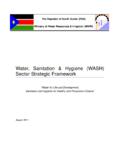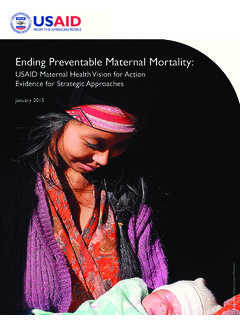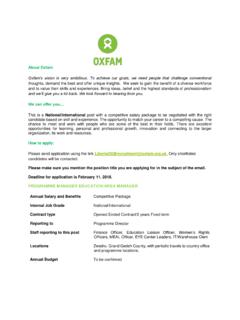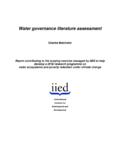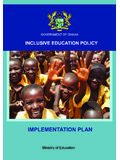Transcription of Water Resources Commission
1 REPUBLIC OF GHANA Water Resources Commission NATIONAL INTEGRATED Water Resources MANAGEMENT (IWRM) PLAN DECEMBER 2012 FOREWORD Government of Ghana s vision of the Water sector is all people living in Ghana have access to adequate, safe, affordable and reliable Water service, practice safe sanitation and hygiene and that Water Resources are sustainably managed . To achieve this vision, Ghana has been engaged in the introduction of Integrated Water Resources Management (IWRM) at various levels of society in the management, development and utilization of its Water and land Resources , and is considerably advanced in the IWRM process resulting in a national Water policy and legislations facilitating Water Resources management and development. Furthermore, an enabling institutional framework has been introduced at national level, establishment of the Water Resources Commission (WRC) and the Water Directorate under the Ministry of Water Resources , Works and Housing, and at local river basin level in the form of creation of river basin boards.
2 In parallel to the organizational arrangements, activities of a more technical and hydrological nature have been undertaken by WRC with support from various stakeholders and Development Partners. WRC s priority task has been to introduce the principles of IWRM at both local and national levels. Six River Basin plans have been developed since 2007 and these have provided vital inputs towards the development of this National IWRM plan. This National IWRM Plan sets out the direction and implementation framework for the legal and institutional development to achieve the overall goal of the Water Resources management part of the National Water Policy. It outlines the need for the sustainable management of all the river basins and related natural Resources in line with the provisions of the WRC s mandate (Act 522 of 1996) and in the context of emerging climate change and trans-boundary issues.
3 This plan should also be viewed as an integral part of the stipulations in the WRC Act to propose plans for utilization, conservation, development and improvement of Water Resources in adherence with the overall National Water Policy. The Plan has been prepared through a consultative and participatory process involving all key sector stakeholders, and will undoubtedly serve as a reference document for the management of Water Resources in Ghana. It is intended to guide and urge the different stakeholders involved in Water Resources management at different levels to incorporate IWRM in their plans, making IWRM an integral part of their development programs, and improve their institutional capacity for Water Resources management. The Commission expresses its sincere appreciation to all those who worked tirelessly to produce this very important plan and to the European Union and all the Development Partners who supported the process.
4 Finally, the Commission sincerely hopes that this plan will be a useful catalyst towards accelerating concrete IWRM activities in Ghana for sustainable socio-economic development. Paul Derigubaa Chairman, Water Resources Commission , Accra, December 2012 National IWRM Plan Ghana Water Resources Commission Page i Contents List of Figures .. ii List of Tables .. iii List of Acronyms .. 1 Executive Summary .. 4 CHAPTER 1 INTRODUCTION .. 8 IWRM in the International Context .. 8 IWRM Planning in the Sub-regional Context .. 9 The IWRM Plan and the Ghana Water sector Planning .. 10 Process of Developing the National IWRM Plan .. 12 CHAPTER 2 SOCIO-ECONOMIC PROFILE AND Water Resources SITUATION .. 13 General Context .. 13 Socio-economic Context .. 13 Bio-physical Context .. 15 Water Resources Potential .. 17 Current and Projected Water demand .. 23 Transboundary Water Resources .. 24 CHAPTER 3 THE LEGAL AND INSTITUTIONAL SITUATION.
5 26 The Enabling Environment for the Water sector in Ghana.. 26 Institutional roles and coordination of the Water sector .. 28 CHAPTER 4 THE Water Resources ISSUES .. 33 CHAPTER 5 THE OPPORTUNITIES AND THE CHALLENGES .. 39 CHAPTER 6 THE IWRM ACTION PROGRAMME .. 41 Introduction .. 41 Policy Objectives for the IWRM Action Programme .. 41 Actions .. 42 CHAPTER 7 MECHANISM FOR IMPLEMENTATION .. 46 Organisational Management: .. 46 CHAPTER 8 MONITORING AND EVALUATION .. 47 ANNEX A: Summary of the WSSDP Themes, Objectives and Strategies .. 49 ANNEX B: Action Sheets .. 51 ANNEX C: References and Websites .. 82 National IWRM Plan Ghana Water Resources Commission Page ii LIST OF FIGURES Figure Strategy and planning framework within the Water sector in Ghana .. 12 Figure Location of Ghana in West Africa .. 12 Figure Ecological zones of Ghana and rainfall distribution .. 13 Figure The River Systems of Ghana .. 18 Figure The Akosombo Dam.
6 19 Figure Geological formations of Ghana .. 21 Figure Transboundary River Basins .. 24 Figure Functional Chart of Water and Sanitation Institutions .. 29 National IWRM Plan Ghana Water Resources Commission Page iii LIST OF TABLES Table Urban and Rural Population Distribution .. 13 Table Contributions to GDP by Kind of Economic Activity (in percentages) .. 14 Table Basic Health sector Indicators .. 15 Table Water Resources Availability .. 17 Table Characteristics of the major impoundments .. 20 Table Water Demand Estimates .. 23 Table Trans-boundary basins in Ghana.. 25 Table M&E for the action program .. 47 LIST OF BOXES Box 1: Definition of IWRM by Box 2: The Ouagadougou National IWRM Plan - Water Resources Commission Page 1 LIST OF ACRONYMS ADRA Adventist Development Relief Agency AfDB Africa Development Bank AMCOW African Ministers Council on Water CC Climate Change CIDA Canadian International Development Agency CONIWAS Coalition of NGOs in Water and Sanitation CRS Catholic Relief Services CSIR Council for Scientific and Industrial Research CWSA Community Water and Sanitation Agency DANIDA Danish International Development Assistance DFID Department for International Development (UK)
7 DHMT District Health Management Team DP Development Partners DSS Decision Support System DWST District Water and Sanitation Team EDF European Development Fund EPA Environmental Protection Agency EU European Union FC Forestry Commission GAEC Ghana Atomic Energy Commission GEF Global Environment Facility GIDA Ghana Irrigation Development Authority GIS Geographic Information System GMet Ghana Meteorological Authority GoG Government of Ghana GWCL Ghana Water Company Limited GWP Global Water Partnership HES Hydro-Environ Solutions Ltd. HSD Hydrological Services Department IGF Internally Generated Funds IMSC Inter-Ministerial Steering Committee IWRM Integrated Water Resources Management IWSPMF Improvement of Water sector Performance Management Framework JICA Japan International Cooperation Agency KPI Key Performance Indicators National IWRM Plan - Water Resources Commission Page 2 LC Lands Commission LFA Logical Framework Analysis LGSC Local Government Service Commission LI Legislative Instrument LVB Lands Valuation Board M&E Monitoring and Evaluation MC Minerals Commission MDAs Ministries, Departments, and Agencies MDGs Millennium Development Goals ME Ministry of Energy MFA-RI Ministry of Foreign Affairs & Regional Integration MJ-AGD Ministry of Justice & Attorney General s Department MLGRD Ministry of Local Government and Rural Development MLNR Ministry of Lands and Natural Resources MMDAs Metropolitan.
8 Municipal and District Assemblies MOFA Ministry of Food and Agriculture MOH Ministry of Health MoU Memorandum of Understanding MOWAC Ministry of Women and Children s Affairs MWRWH Ministry of Water Resources , Works and Housing NADMO National Disaster Management Organisation NDPC National Development Planning Commission NWP National Water Policy NWV National Water Vision PURC Public Utilities and Regulatory Commission RBBs River Basin Boards RCCs Regional Coordinating Councils SEA Strategic Environmental Assessment SIP Strategic Investment Plan SWAp sector Wide Approach UNDP United Nations Development Programme UNEP United Nations Environment Programme UNICEF United Nations Children Fund USAID United States Agency for International Development VBA Volta Basin Authority VRA Volta River Authority WASH Water , Sanitation and hygiene National IWRM Plan - Water Resources Commission Page 3 WATSANS Water and Sanitation Teams WB World Bank WD Water Directorate WRC Water Resources Commission WRI Water Research Institute (CSIR) WRIS Water Resources Information Services WRM Water Resources Management WSMP Water and Sanitation Monitoring Platform WSSD World Summit for Sustainable Development (2002) WSSDP Water sector Strategic Development Plan WSSPS Water Supply and Sanitation Programme Support (DANIDA) National IWRM Plan - Water Resources Commission Page 4 EXECUTIVE SUMMARY By developing the present National IWRM Plan, Ghana is following the formal international recommendations (WSSD Plan of Implementation) as well as the agreements made by the ECOWAS countries on developing IWRM through national planning.
9 However, Ghana has during the years from the first conceptual emergence of IWRM in the early 1990s, put in place a good part of the basic political, legal and institutional frameworks, which eventually will sustain the implementation of IWRM in the country. Some notable programmes and actions already in place include: - i) the establishment of the Water Resources Commission by an Act of parliament in 1996; ii) the adoption of the 2007 National Water Policy (NWP); iii) the development of five national river basin IWRM plans and four corresponding River Basin Boards (RBBs) between 2003 and 2011; and iv) the active involvement with neighbouring countries on trans-boundary issues on the Volta Basin. In addition, substantial capacity building has taken place within the key institutions involved in Water Resources management over the past 15-20 years. Ghana s approach to implementation of IWRM has gone through strengthening basic parts of the central Enabling Environment and by initiating the planning from the river basin level, starting with the most Water stressed basins of the country.
10 At a later stage, the lessons learnt in implementing these basin plans have provided input to further basin planning and to the preparation of the National IWRM Plan which role actually is to fill the institutional gaps after more basic IWRM functions already have been implemented and lessons learned. The National IWRM Plan shall be seen in the context of the overall development planning and in particular the Water sector planning in Ghana. Thus, the overarching planning framework is the Ghana Shared Growth and Development Agenda under which sectoral policies and development plans are elaborated. For the Water sector , the next level is the NWP (adopted in 2007). The NWP in Ghana covers both the productive part of the Water sector ( Water supply and sanitation) and the cross-sectoral Water Resources management part (IWRM). Therefore, the Water sector Strategic Development Plan (WSSDP) being the implementation framework for the NWP consists of three separate strategic planning components, namely i) The national IWRM Plan ii) The Urban Water Supply Strategy, and iii) The Rural Water Supply and Sanitation Strategy.
